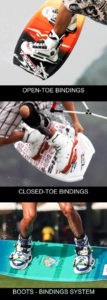Tips by David Ngiam
 Bindings are the only thing that keeps you connected to your board. How responsive a board is pretty much depends on how good a fit your bindings are. Not to mention how well it protects your ankle from unneccesary injuries as well. A tight binding may be uncomfortable intially, but a loose binding can be potentially harmful. Firstly, you won’t have as much control over your board, espcially when edging and popping. Its like running a sprint race with loose shoes. Secondly, your ankles are not well supported if you have a bad fall or an uneven landing. Generally, I like a binding that is firm and tight, but doesn’t feel too tight at least for the first 15-20 minutes of non-stop riding.
Bindings are the only thing that keeps you connected to your board. How responsive a board is pretty much depends on how good a fit your bindings are. Not to mention how well it protects your ankle from unneccesary injuries as well. A tight binding may be uncomfortable intially, but a loose binding can be potentially harmful. Firstly, you won’t have as much control over your board, espcially when edging and popping. Its like running a sprint race with loose shoes. Secondly, your ankles are not well supported if you have a bad fall or an uneven landing. Generally, I like a binding that is firm and tight, but doesn’t feel too tight at least for the first 15-20 minutes of non-stop riding.
Bindings with higher cut boots give you better ankle support and generally gives you more leverage when edging. Lower cut bindings or bindings with more flexible upper lets you tweak out your tricks a little more. If you ride without any bindings at all, that’s called wakeskating.
Bindings can also be open or closed toe. Ie. your toes are exposed for open-toe bindings. Some people find that closed-toe bindings help them edge better, and obviously, keeps their toes warmer when riding in cold water. However, some people prefer open-toe bindings because it has better water drainage and doesn’t give them ‘toe jam’ – where the toes hit the front of the boot, which can be painful on hard landings.
There are also manufacturers that have separate boots and binding systems, similar to snowboards boots & bindings. These systems are generally popular at wake parks where the rider always has his boots on which may be more comfortable if he has to take a long walk back to the starting dock.
